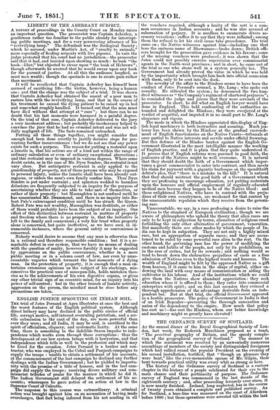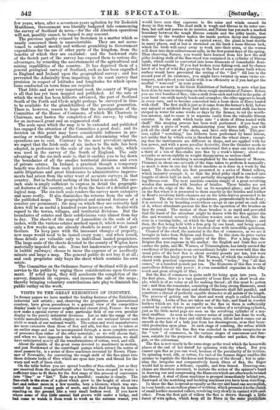THE ORDNANCE SUItYEY OF SCOTLAND.
AT the annual dinner of the Royal Geographical Society of Lon- don, last week, Sir Roderiok Murchison proposed as a toast, " The practical geography of Britain, and the speedy comple- tion of the geographical survey of Scotland." The manner in which the sentiment was received by an unwontedly numerous assemblage of members of the society and distinguished foreigners which had rallied round the popular President on the evening of his second installation, testified, that " though on pleasure they were bent," like the ever-memorable spouse of Mr. Gilpin, their bent towards practical utility was every whit as strong as hers.
The history of the Ordnance survey of Scotland is a curious chapter in the history of a people celebrated for their eye to the main chance and their pertinacity of purpose. The Ordnance survey of England was commenced in the last decade of the eighteenth centuryand., after proceeding leisurely ever since, it is now nearly finished. Ireland, long neglected, has in the course of twenty years obtained a complete and published survey. As for Scotland, a base-line was measured on the coast of Aberdeen before 1800 ; but these operations were arrested till within the last few years, when after a seventeen-yearsitation by Sir Roderick Murchison, Government was literally baadgered into commencing the survey of Scotland de novo,—for the olld Aberdeen operations will not, possibly cannot, be turned to any account. The previous apathy evinced by Scotsmen in a matter which so nearly concerned them is unaccountable. They are not accus- tomed to submit meekly and without grumbling to Government expenditure for the use of other parts of the kingdom, from the benefits of which they are excluded : and the backward state of the Scotch part of the survey has exposed them to serious dis- advantages, by retarding the ascertainment of the agricultural and mining capabilities of the country. It has deprived them of a general geological survey of Scotland, such as has been engrafted in England and Ireland upon the geographical survey; and has prevented the Admiralty from imparting to its coast survey that precision in respect of latitudes and longitudes for which opera- tions conducted on terra firma are required. That little and not very important nook the county of Wigton is all that has yet been mapped and published. At the rate at which the work has been hitherto advanced, the part of Scotland South of the Forth and Clyde might perhaps be surveyed in time to be available for the grandchildren of the present generation. There is, however, reason to hope that the investigations of the Committee of the House of Commons, of which Mr. Charteris is Chairman, may hasten the completion of this survey, by calling for an increased grant and an augmented staff.
The scale upon which the map is to be extended and published has engaged the attention of the Committee a good deal; and its decision on this point may have considerable influence in pro- moting or retarding the publication, and determining what the operations are to cost. Contrary to the most prevalent opinion, we regret that the Irish scale of six inches to the mile has been adopted, in preference to the scale of one inch to the mile, which was used in the survey of the South of England. The only advantage of the six-inch scale is, that it enables you to lay down the boundaries of all the smaller territorial divisions and even of private estates. In Ireland, a practical though a temporary benefit was derived from such minuteness, inasmuch as intermi- nable litigations and great hinderance to administrative improve- ments had arisen from the utter want of accurate surveys in that country. But in Scotland nothing of the kind is needed. The one- inch scale is amply sufficient to express in detail the geographi- cal features of the country, and to form the basis of a detailed geo- logical map. The six-inch scale renders the survey more extensive and more costly. It also diminishes the returns from the sale of the published maps. The geographical and mineral features of a country are permanent ; the map on which they are correctly laid down will be as useful a hundred years hence as now. So also with regard to the towns, villages, and territorial divisions. But the boundaries of estates and their subdivisions vary almost from day to day. The sheets of the map of .Lancashire on the scale of six inches, with the various estates marked upon it, which were issued only a few weeks ago, are already obsolete in many of their par- ticulars. To keep pace with the incessant changes .of property, new maps would need to be issued every year ; and when issued, these details are valuable only to individual landed proprietors. The Iarge scale of the sheets devoted to the county of Wigton have materially impeded the sale. None but landowners (or speculators in bubble railways) choose to incur the expense of so needlessly minute and large a map. The general public do not buy it at all ; and each proprietor only buys the sheet which contains his own estate.
The Committee on the Ordnance Survey of Scotland will do good service to the public by urging these considerations upon Govern- ment. If acted upon, they will accelerate the completion of the survey, diminish its expense, and increase the sale of the maps ; thereby bringing voluntary contributions into play to diminish the public outlay on the work.



























 Previous page
Previous page